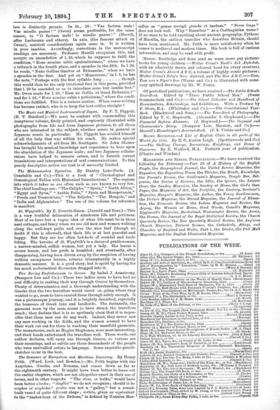Oak/2/ns with the Pervigilium Veneris. Edited by S. G. Owen.
Illustrated by J. R. Weguelin. (Lawrence and Bullen.)— Catullus. Edited by Elmer Truesdell Merrill. (Ginn and Co., Boston, U.S.)—Mr. Owen's volume is an edition de luxe. It has broad margins, hand-made paper, large and admirably legible type, with eight illustrations of unequal merit. Lesbia and her lover, in illustration of " ille mi par esse deo videtur," strikes one as very good, while Ariadne on the shore of Naxos is but little behind. On the other hand, the " Aequoreae llonstrum Nereides admirantes " is not very intelligible. It is not easy to understand the distances. How far off is the ship supposed to be from the figure in the foreground ? The notes are mainly critical, and show a scholarly appreciation of the difficulties which are encountered in dealing with the text of Catullus. Professor lltIerrill's edition is of a more businesslike kind. He examines in great detail all the questions that arise in connection with the life of Catalina His Introduction is, on the whole, as thorough and as satisfactory a piece of work as we have ever seen on this subject. His annotation is copious, and deals with both criticism and exegesis. It may fairly be said that he leaves nothing untouched. We do not see why pales, in iv., 21, " Phaselus ille," must be taken to mean "the two halves of the sail itself." The following wind kept the two " sheets,"—i.e., ropes attached to the corners of the sails,—equally taut. This is just. as descriptive of the situation as to say that it evenly filled the two halves of the sail. In
7, 8, we prefer Mr. Owen's reading (after Professor Postgate) of-
" Et solaciolum sui &Ilona, Credo, et quo gravis adqniescat ardor,"
to Professor liferrilPs sit turn, though the latter is nearer to the MSS. Mr. Owen has the better feeling for what suits .the verse, probably from being a writer of verse himself. Ut turn is distinctly prosaic. In iii., 16: " Vae factum male ! Vae miselle passer ! " (Owen) seems preferable, for the same reason, to "0 factum male ! io miselle passer ! " (Merrill, after Lachmann and others). In axis. (the famous attack on Ccesar), metrical considerations again come in. It is written in pure iambics. Accordingly, corrections in the manuscript readings are necessary. Professor Merrill recognises this, and accepts an emendation of 1. 23, which he supposes to fulfil the condition," Eone nomine urbis opnlentissimae," where we have a tribrach in the fourth place, and a spondee in the fifth. In L 20, he reads, " Nunc Galliae timetnr at Britanniae," when we have a spondee in the first. And yet on " Mamurram," in L 3, he has the note, "Perhaps with the first syllable long though this would then be the only irrational foot in this poem, provided that 1. 23 be amended so as to introduce none but iambic feet." Mr. Owen reads for 1. 20, " Eum ne Gallia et timet Britannia ?" and for 1. 23, " Bone nomine urbis o potissimae," where the condi- tions are fulfilled. This is a serious matter. When verse-writing has become extinct, who is to keep the text-critics straight ?







































 Previous page
Previous page